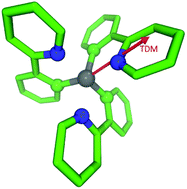Calculating transition dipole moments of phosphorescent emitters for efficient organic light-emitting diodes†
Abstract
The out-coupling of light from an organic light-emitting diode, and thus its efficiency, strongly depends on the orientation of the transition dipole moment (TDM) of the emitting molecules with respect to the substrate surface. Despite the importance of this quantity, theoretical investigations of the direction of the TDM of phosphorescent emitters based on iridium(III) complexes remain limited. One challenge is to find an appropriate level of theory able to accurately predict the direction of the TDM. Here, we report relativistic time-dependent density functional theory (TDDFT) calculations of the TDM, emission energies and lifetimes for both the ground-state (S0) and triplet (T1) excited-state geometries of fac-tris(2-phenylpyridyl)iridium(III) (Ir(ppy)3), using the two-component zero-order regular approximation (ZORA) or including spin–orbit coupling (SOC) perturbatively using the simpler one-component (scalar) formulation. We show that the one- and two-component approaches give similar emission energies and overall radiative lifetimes for each individual geometry. Use of the S0 geometry leads to two of the excited triplet substates being degenerate, with the degeneracy lifted for the T1 geometry, with the latter matching experiment. Two-component calculations using the T1 geometry give results for the direction of the TDM more consistent with experiment than calculations using the S0 geometry. Finally, we show that adding a dielectric medium does not affect the direction of TDM significantly, but leads to better agreement with the experimentally measured radiative lifetime.

- This article is part of the themed collection: 2019 PCCP HOT Articles


 Please wait while we load your content...
Please wait while we load your content...